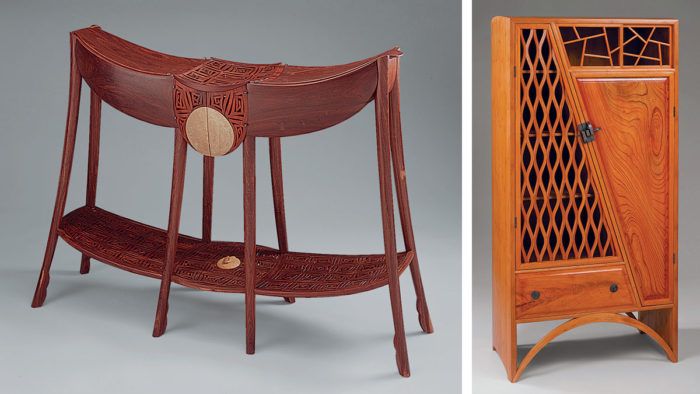West Meets East
Peabody Essex Museum exhibit highlights furniture inspired by China
Synopsis: For centuries, while China was closed to foreigners, Chinese forms found their way into Western furniture. From the frothy fretwork of Chinese Chippendale to the cabriole legs on Queen Anne tables, China has been with us whether we knew it or not. Inspired by China, an extraordinary show at the Peabody Essex Museum in Salem, Mass., asked 22 American, Canadian, and Chinese makers to participate in a three-day workshop on Chinese furniture at the museum. Then each maker built a piece in response to that experience. In this back cover feature, freelance editor Jonathan Binzen briefly describes the show and highlights the work of three artists. The museum also has information about the exhibit on its Web site (www.pem.org).
For centuries, while China was closed to foreigners, Chinese forms found their way into Western furniture. From the frothy fretwork of Chinese Chippendale to the cabriole legs on Queen Anne tables and the bamboo-style turnings on Windsor chairs, China has been with us whether we knew it or not. Inspired by China, an extraordinary show at the Peabody Essex Museum in Salem, Mass., asked 22 American, Canadian, and Chinese makers to participate in a three-day workshop on Chinese furniture at the museum. Then each maker built a piece in response to that experience. The inspiring new pieces are on view alongside a selection of the antique Chinese furniture that inspired them. Those who miss the show will be consoled by the superb catalog (www.pem.org).
Michael Hurwitz’s display cabinet (24 in. deep by 36 in. wide by 78 in. tall), one of a pair, folds materials and methods of Chinese furniture making into his Japanese-tinged aesthetic. The traditional Chinese “cracked-ice” pattern in the small sliding doors is balanced by his own squiggly, bent-laminated latticework on the left. The carcase is bamboo veneer, and the solid-panel door is made from a prized plank of zelkova Hurwitz bought years ago in Japan.
J.M. Syron and Bonnie Bishoff drew on details of Chinese furniture for their altar coffer’s raised ends and exuberantly scrolled skirt and corbels. A Chinese tapestry inspired the seascape on the panels. Syron built the mahogany cabinet (18 in. deep by 32 in. wide by 26 in. tall) and Bishoff pieced together the stylized seascapes in marquetry fashion, using “veneers” of polymer clay. She also used polymer to create the illusion of “cracked ice” latticework over the seascape.
From Fine Woodworking #189
For the full article, download the PDF below:
Fine Woodworking Recommended Products

Circle Guide


Sketchup Class























Log in or create an account to post a comment.
Sign up Log in